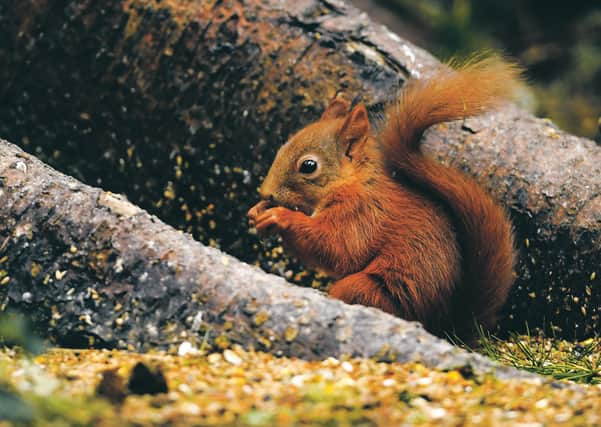Rewilding Scotland: Hopes of returning bison, wolves and lynx should not overshadow loss of less high-profile species – Stephanie Wray


The recent news that a pair of golden eagles in the Scottish Highlands had reared offspring for the first time in four decades was hailed by many as a rewilding story beyond anyone’s wildest dreams.
Elsewhere in Scotland there have been other successful recent rewilding efforts. Beavers have been successfully returned to the wild, the first mammal to be officially reintroduced in the UK. And it’s not just in Scotland either: red kites have been saved from being a globally-threatened species in the 1980s and are now thriving across England, white-tailed eagles have been brought back in southern Britain for the first time in more than 200 years and pine martens making a comeback after near extinction. Soon, bison will be introduced for the first time in Kent and before long we could even be seeing the likes of lynx and wolf roaming parts of Britain.
Advertisement
Hide AdAdvertisement
Hide AdBut these success stories mask the fact we’re facing a wider crisis in conservation. While newsworthy species like golden eagles and bison make the headlines, a recent report by the Mammal Society shows that a quarter of mammals native to the UK are at risk of extinction with the likes of greater mouse-eared bats on the critically endangered list and another 45 native species – many of which we take for granted – at risk.
Rewilding allows species to act as ‘nature’s engineers’ in creating a sustainable working landscape, repairing land battered through climate change, overdevelopment or over-intense farming. Bison, for example, are unique in that they fell trees by rubbing up against them and eat bark, creating areas of space and light in the woods and providing deadwood that assist other plants and animals. Beaver dams create new wetland areas that allow frogs, fish, waterbirds and otters to thrive. Pine martens can help control grey squirrels. Lynx and wolves could help keep roe deer populations under control more naturally.
Not surprisingly, the prospect of wild or exotic animals that have been lost for hundreds of years or never before seen in Britain being re-introduced into our countryside generates plenty of excitement. But with much of the focus on bringing in ‘superstar species’ at the top of the ladder, we risk losing sight that rewilding requires a ground-up, as well as a top-down approach in order for the whole biodiversity chain to thrive.
As the Mammal Society report makes clear, species that are an essential part of the ecosystem are in decline. The society classes familiar animals such as the red squirrel and water vole as endangered – the second most urgent category in its report – and even hedgehogs fall into the vulnerable bracket.
These species are just as important as the more exciting ones that create the headlines. Water voles, for example, improve bankside plant diversity through the creation of their burrow networks, crucial to crucial for a thriving wetland ecosystem. Hedgehogs are an indicator species for the wider health of the environment because they feed on soil invertebrates, so a significant fall in numbers suggests the quality of the natural world has substantially decreased.
Many people’s perception of what rewilding means has been influenced by stories of the re-introduction of long-lost species, but in fact rewilding can be anything from reintroducing the likes of wolves to an area to more basic interventions such as digging ponds, introducing dormice or beavers to a site, planting trees or reinstating peatland, or simply leaving land to ‘do its own thing’. The crucial thing is that we need a whole system approach.
One positive of Covid-19 was that many of us started to re-appreciate the rich diversity of our environment. A survey published by Scottish National Heritage found the number of people venturing outside to explore the countryside, enjoy wildlife and boost their mental and physical health increased substantially during lockdown. The re-introduction of ‘box-office draws’ like bison, wolves or lynx may be thrilling but they will, after all, be limited to restricted areas. Most of us, when we go outside to enjoy the countryside, will still be more likely to wander through quieter woodland or pond environments. But the rich diversity of species that live there will be lost forever in the future unless we heed the warnings of today.
Stephanie Wray is an ecologist and managing director of RSK Biocensus
A message from the Editor:
Advertisement
Hide AdAdvertisement
Hide AdThank you for reading this article on our website. While I have your attention, I also have an important request to make of you.
With the coronavirus lockdown having a major impact on many of our advertisers - and consequently the revenue we receive - we are more reliant than ever on you taking out a digital subscription.
Subscribe to scotsman.com and enjoy unlimited access to Scottish news and information online and on our app. With a digital subscription, you can read more than 5 articles, see fewer ads, enjoy faster load times, and get access to exclusive newsletters and content. Visit www.scotsman.com/subscriptions now to sign up.
Our journalism costs money and we rely on advertising, print and digital revenues to help to support them. By supporting us, we are able to support you in providing trusted, fact-checked content for this website.
Joy Yates
Editorial Director
Comments
Want to join the conversation? Please or to comment on this article.